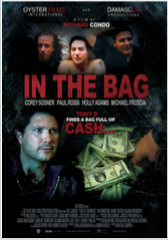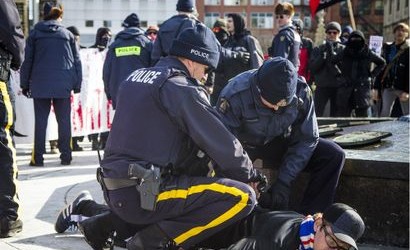There are so many Mounties needed to process illegal border crossings in rural Quebec that the federal government is now spending $250,000 to build an unofficial police station on the U.S. border. In Toronto last week,
Mayor John Tory announced that the number of refugee claimants in the city’s shelter system has quadrupled from 459 per night in 2016 to an average of 2,351 in 2018. And at least one Quebec politician is calling for a border fence with the U.S.These are just some of the repercussions of the more than 20,000 illegal border crossings into Canada since early 2017, all of them made by foreign nationals seeking asylum. With the influx expected to grow even bigger this summer, here are the details of Canada’s ongoing migrant crisis.
Illegal border crossers are outpacing conventional refugees for the first time
In the first three months of 2018, 5,052 asylum seekers were intercepted by the RCMP after illegally crossing the Canadian border, compared to 4,475 people who filed refugee claims through conventional channels such as airports and official border stations. In other words, for the first time there are more people illegally seeking asylum in Canada than making legal refugee claims — and that trend is set to continue throughout 2018.
In 2017, the Immigration and Refugee Board received at least 18,149 claimsfrom what they call “irregular border crossers” — those who claimed asylum after first entering Canada illegally. This was compared to 29,276 people who applied for refugee status through legal channels. But with the rate of illegal crossings already double what it was in 2017, the “illegal” category is poised to blow past the “legal” category.

The RCMP intercepted 1,890 illegal border crossers in the first three months of 2017. In the same period in 2018, that number soared to 5,052. Over the Easter Weekend alone, more than 600 crossed into Quebec, and provincial officials are expecting more than 400 per day as the weather gets warmer. Much of this activity is in Saint-Bernard-de-Lacolle, Que., where it’s particularly easy to cross over from Champlain, New York.
These are “illegal” border crossings, but Canadian law does not view the border crossers as criminals
When the migrant crisis has been discussed in the House of Commons, it has often been accompanied by robust argument over the use of the term “illegal migrant.” The Conservatives use the term, while the Liberals and the NDP prefer the term “irregular migrants” (and accuse the Tories of fear-mongering). It is illegal to cross into Canada without first passing through a port of entry. Indeed, any border-crosser at Saint-Bernard-de-Lacolle will pass by a bilingual sign saying “it is illegal to cross the border here” — and they will also be told as much by the area’s substantial police presence. However, while someone can be charged for entering Canada without authorization, those charges are waived once someone makes an asylum claim.
By any measure, the backlog is out of control
Well before the first day of summer, the number of asylum seekers who entered Canada illegally will surpass the 25,000 Syrian refugees accepted into the country in 2016. These border crossings — coupled with rising rates of refugee claims across the board — are putting an unsustainable strain on the country’s refugee system. At the beginning of 2017, the Immigration and Refugee Board counted a total queue of 18,644 refugee claimants. As of March 31, this has more than doubled to 48,974.
Even if refugee claims stopped tomorrow, this would be a daunting number, given that the Immigration and Refugee Board can only process about 1000 to 2,000 cases per month. And the claims keep coming. In March, the board was able to finalize a then-record 2,587 claims, but this was dwarfed by the 4,078 new refugee claims that piled up in the same month.
The backlog is complicated even further by the fact that illegal border crossers are already in the country when they file refugee claims. If Canada rejects an overseas immigrant, the decision is final. For a refugee claimant on Canadian soil, meanwhile, rejections are subject to a lengthy process of appeals, removal orders and, in extreme cases, Canada-wide arrest warrants.
The Conservatives claim that a single Trudeau tweet started this (and they might have a point)
In January last year, Prime Minister Justin Trudeau tweeted, “to those fleeing persecution, terror & war, Canadians will welcome you, regardless of your faith.” It was a direct response to U.S. president Donald Trump’s so-called “travel ban,” an executive order banning all travel from seven countries with large Muslim populations. Trudeau’s post has received 412,000 retweets to date, making it one of the most circulated tweets of 2017. In a recent House of Commons speech, Conservative public safety critic Pierre Paul-Hus called the tweet “the root of” illegal border crossings. And the data seems to back him up. The month before the Tweet, the RCMP intercepted 315 illegal border-crossers. The next month that doubled to 678 — and kept climbing until it reached a peak of 5,712 by August, 2017.
Emails obtained by the National Post also revealed that the tweet caused widespread confusion among Canadian diplomatic officials as they were deluged with inquiries. “We are receiving an increasing number of enquiries from the public about requesting refugee status in Canada, and a number clearly having links with our Prime Minister’s tweet this weekend,” wrote one diplomat stationed at Canada’s Mexican embassy.
Much of this is arguably happening due to an easily patched legal loophole
Canada faced its last major wave of migrants from the United States in the aftermath of the September 11th attacks. This prompted the government of Jean Chretien to draw up the Safe Third Country Agreement with the United States. This agreement holds that any non-American seeking refugee protection at the U.S./Canada border must have first filed a refugee claim with the Americans. Thus, it effectively allows guards at Canadian land borders to turn away most asylum seekers on the grounds that they are already in a safe country. There’s just one problem: The agreement only refers to refugee claims made at a “port of entry.” Thus, if someone slips past a port of entry and enters Canada illegally in order to make an inland asylum claim, the agreement doesn’t apply.
As Conservative immigration critic Michelle Rempel has pointed out, however, the agreement gives Canada’s Minister of Immigration a wide berth to decide what constitutes a “port of entry.” Were Immigration Minister Ahmed Hussen to declare the entire Canadian border a port of entry, officials could turn away many over-land asylum claimants from the United States without passing their claims on to the Immigrant and Refugee Board.
It’s unlikely illegal crossings will stop on their own
When the wave of border-crossing began in early 2017, the migrants were reported to be mostly Haitians fearing deportation from the U.S. after Trump announced the end of temporary amnesty enacted in the wake of the 2010 Haiti earthquake. Recently, the demographics have changed and border-crossers are now predominantly Nigerian. What’s more, most appear to be entering the United States on recently acquired tourist visas for the sole purpose of slipping into Canada. “They land in the United States, where they stay for a very short period of time, and then make their way to Canada,” Hursh Jaswal, communications director for Immigration Minister Ahmed Hussen, told the Canadian Press.
Once an asylum seeker is deemed to be a refugee claimant, they are able to obtain work permits, as well as access to Canadian healthcare, public schools and even social assistance. It’s unknown how many border-crossers will be deemed true refugees, but considering the millions of Mexicans who have crossed the Rio Grande for far less, it’s easy to see to why economic factors might keep thousands of people streaming through southern Quebec. Illegally crossing the border is also quicker than legal refugee channels. Currently, even a sponsored refugee from Ethiopia faces a wait time of at least five years. For Indians, it’s seven years.
If the backlog keeps up, border-crossers could conceivably be facing “de facto amnesty”
From a technical standpoint, many of the folks crossing at Champlain, N.Y., are not particularly strong candidates for refugee status. According to the federal government, the refugee system is meant to protect people who face death, “danger of torture” or cruel and unusual punishment if they return to their home country. Some claimants from Haiti and Nigeria will fit that description, such as gay men or those from places threatened by Boko Haram. But unlike Syria or Afghanistan, neither country fits the criteria for a war zone. Of the 2,552 claims from illegal border crossers that were finalized in 2017, only 53 per cent were accepted as refugees. The federal governmenteven dispatched Haitian-born MP Emmanuel Dubourg to Miami to tell Haitians directly that most of them will be deported if they try to cross into Canada. But as the backlog piles up, it is taking longer and longer to process refugee claims. In October the wait time was 16 months. In February, it was 20 months. According to an internal report from the Immigrant and Refugee Board, if current rates of border crossing continue, the wait could be as long as 11 years by 2021. A 19-year-old crossing the border could be 30 with three kids by the time he ever has to make his case for staying in Canada. “Realistically, if it’s going to take 10 years to get a refugee hearing … you’ve almost got de facto amnesty,” said Raj Sharma, a Calgary-based immigration lawyer and former refugee protection officer.
• Twitter: | Email: [email protected]


















